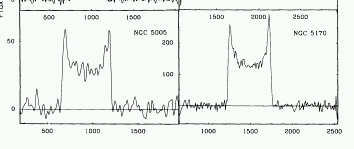Tully-Fisher relation

Thus measuring the width of the line we get a direct estimate of the circular velocity. Conventionally, this width is measured by finding the points in the line wings where the intensity has dropped by 20% of the peak value. The difference in Doppler shift between these 2 points is W20.
W20 needs to be corrected for 2 effects. The first one is that HI does not follow perfectly circular orbits, but has some random motion, whose effect is to broaden the observed lines. This can be estimated to be typically 10 km/s. The second effect is due to the inclination. The width that we measure is essentially 2 Vc sin i. Therefore, the quantity
WR = (W20- Wrand)/sin
i
is an inclination independent measure of the circular velocity of a spiral galaxy.
The best bands to measure the brightness of a spiral galaxy are the infrared bands. The reason is twofold:
- spiral galaxies have large amounts of dust, which produce extinction. The effect of extinction in the infrared is very small
- the light will be dominated by old stars, which are more representative of the overall stellar populations. The observed light does not depend therefore on current star formation activity.
The relations obtained are
and have been calibrated using cepheid distances.